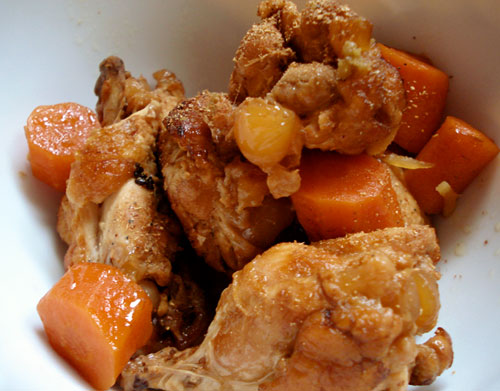
This is another everyday go-to dish around here. Chicken wings are not nearly as cheap as I remember them being during my frugal student days, due to the popularity of things like Buffalo wings. They're still a pretty good deal though. While we love crispy oven-fried wings and such, these deeply flavored braised wings are a great leave-to-cook favorite, especially when the weather gets cold.
This is a dish that is very easy to throw together.
Filed under:
japanese winter chicken favorites slowcook
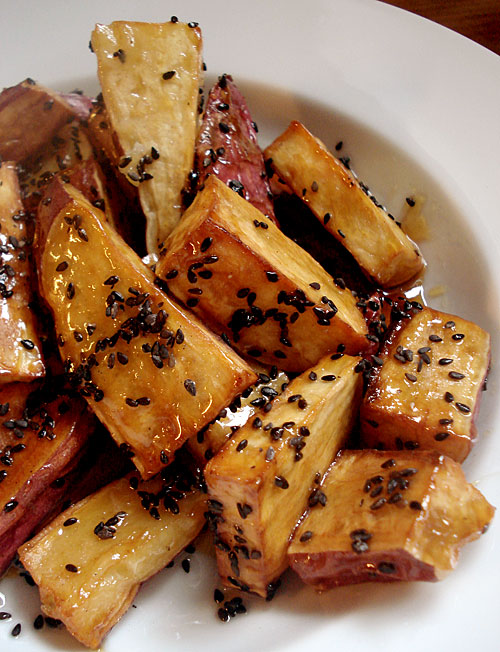
In the fall, many universities throughout Japan have big festivals called 大学祭 daigaku-sai, meaning university festival, or 文化祭 bunnkasai, Culture Festival. They are basically street fairs held on campus, with lots of food and fun stalls, concerts, even ghost houses and amusement rides. Many of the big ones also hold concerts in which top Japanese singers and bands appear. Daigaku Imo, which means University Potato, are candies sweet potatoes, a sweet and slightly savory snack that is often served at university festivals in Tokyo.
The snack itself probably originated as a cheap, calorie-rich, affordable snack sold to cash-poor students around universities in Tokyo around the turn of the 20th century. The idea for deep frying and then sugar coating potatoes most likely came from similar snacks in Chinese cuisine.
Daigaku imo is simple to make, yet a bit tricky. You ideally want to coat the sweet potato slices completely with a hard caramel sugar coating, but too often the sugar gets crystallized. It doesn't taste bad when it does, but it looks far better with a shiny, smooth coating. I've found the best way to accomplish this is to make a fresh batch of the sugar coating for each batch of potatoes cooked. This is not diet food by any means, but regardless, to me they are one of the main treats of fall.
Filed under:
dessert japanese fall vegan gluten-free party snack
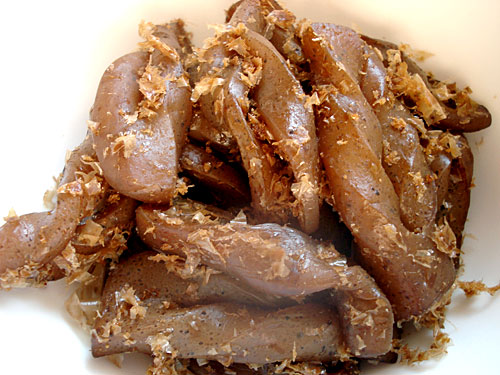
I have talked about konnyaku before, the almost zero calorie, rubbery-jellylike food that makes me really wonder at the ingenuity of people of the past. Why would they think that an almost flavorless, almost nutrient free substance would be edible?
Well, konnyaku is not about its innate flavor - it's all about texture. And since it realy has so little calories, it's a great addition to meals for the dieter, giving a feeling of fullness.
Here are a couple of easy and traditionally Japanese side dishes uses konnyaku. Konnyaku no tosani is konnyaku that is cooked in a flavorful liquid and tossed with plenty of katsuobushi (bonito flakes). __Konnyaku kinpira_ is konnyaku sautéed with sesame and chili pepper.
I tend to make konnyaku dishes when I want to really watch the calories, but still have a hearty appetite.
Filed under:
japanese lighter washoku vegetables kinpira
Submitted by maki on 13 October, 2008 - 16:29
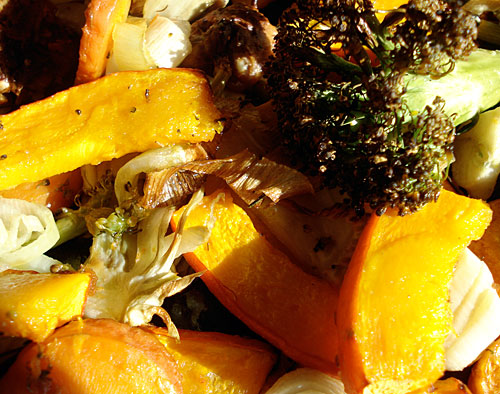
Following up on the previous post where I asked about your favorite go-to everyday dishes (keep your ideas coming!) I thought I'd introduce some of mine. The posting of them may be sporadic, since I'll be taking pictures and things when I actually made them for dinner.
First up is something that is very easy to assemble, quite healthy, cheap, as seasonal as you want it to be, and almost infinately variable. It's simply roasted vegetables. I make this all the time, throughout the year, using whatever vegetables I have. It's a good refrigerator-clearer too.
Type:
recipe Filed under:
basics vegetables vegetarian favorites

Being a sucker for anything On Sale, a couple of weeks ago I was lured by a big AKTION sign at the supermarket into buying a 3 kilo (about 6.6 lb) bag of sweet red peppers. As much as I love peppers, it was going to be impossible to consume all of it in regular ways. Making a jam or jelly out of them was an obvious answer.
I wanted a jam that could be used as condiment or sauce as well as in regular jam-like ways, e.g. spread on bread. I set about trying to find a good, easy to make and not too sugary red pepper jelly or jam recipe on the internets, but nothing I read really stood out on its own to me. So I set about taking this from that and that from the other recipe, and after ruining about a kilo of the peppers in the first attempt, came up with something that is not bad at all.
Filed under:
preserves and pickles vegan
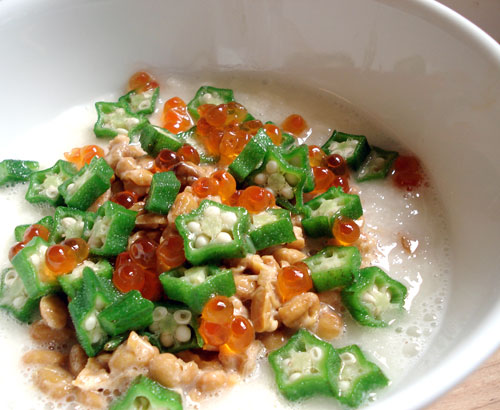
You want slime? I'll give you slime multiplied!
Filed under:
japanese natto offbeat washoku nagaimo slimy
[From the archives: Today (September 23rd) is the first day of the fall o-higan (お彼岸), when ohagi or botamochi are offered to ones ancestors, as well as oneself! My mother and my grandmother always made these at home around this time of year - I love their not-too-sweet stickiness. O-higan ends on the 26th, so if you like wagashi, why not give these a try? Originally published March 2007.]
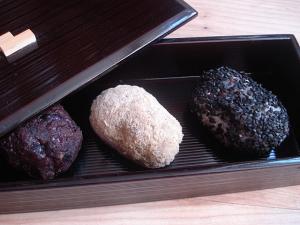 The seven days centered around the bi-annual days of the vernal equinox is a Buddhist festival period known as higan (or o-higan for the honorific term) in Japan. The fall (autumn) higan is aki no higan, and the spring higan is haru no higan. Since the day of the spring equinox is March 21, we're about to enter the haru no ohigan period.
The seven days centered around the bi-annual days of the vernal equinox is a Buddhist festival period known as higan (or o-higan for the honorific term) in Japan. The fall (autumn) higan is aki no higan, and the spring higan is haru no higan. Since the day of the spring equinox is March 21, we're about to enter the haru no ohigan period.
During haru no higan, a sweet confection called botamochi is eaten. The mochi part means sticky, pounded rice, and the bota part comes from botan, or the tree peony. Botamochi is supposed to ressemble a tree peony flower.
During the autumn equinox (aki no higan or simply (o)higan)) period, a very similar confection called ohagi is eaten. This is supposed to look like a hagi or bush clover flower (Latin: Lespedeza thunbergii). Botamochi and o-hagi look the same to me, even though a hagi flower looks nothing like a tree peony flower, but the good old ancestors were probably a lot more imaginative than I am.
Botamochi and o-hagi are made of sticky rice and sweet tsubuan, 'chunky-style' sweet azuki bean paste. They are a bit fiddly to make but not difficult, especially if you use one of my favorite cooking helpers, plastic cling film. Since these are best eaten freshly made, it's well worth the effort to make them at home if you like bean-based Japanese sweets. You can adjust the amount of sugar in the tsubuan to your taste. Here I have made three variations: coated with black sesame seeds; coated with kinako (toasted soy bean powder); and the most traditional form with the rice cake wrapped in a layer of the tsubuan.
Filed under:
dessert japanese legumes rice vegetarian sweet vegan gluten-free wagashi
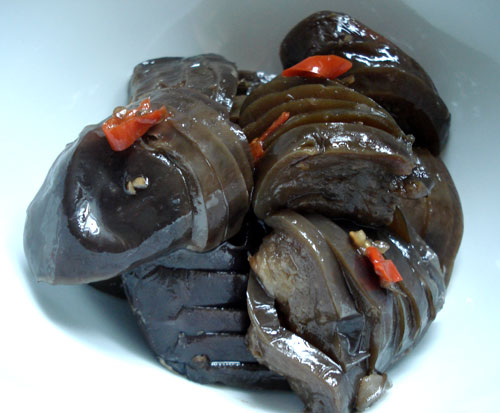
It's hard to take an appetizing picture of this eggplant (aubergine) dish. But I promise you that it's absolutely delicious. Plus, it's so simple to make, requiring just 6 ingredients and water.
I found it in an old Japanese cooking magazine, which had an even worse photo of the dish than the one here. I was a bit sceptical but had bought a too-big batch of eggplant at the market, and wanted a way to use some of them up. I am so glad I tried the recipe, because it's now one of my favorite ways to have eggplant. And it's vegan too.
There's a saying in Japanese, akinasu yome ni kuwasuna (秋なす 嫁に食わすな). It means "Don't let your daughter in law eat fall eggplants". People debate what the intent of this saying is; does it mean that fall eggplant are too delicious to feed to the daughter in law, who was traditionally the lowliest member of the family? Or perhaps it's a thought of kindness, since eggplant is supposed to be a 'cooling' vegetable, which is not good for a pregnant or fertile young woman. Either way, there's no doubt that eggplant is particularily delicious in late summer to early fall, when they usually produce a second crop after a first one early on.
Filed under:
japanese vegetables vegetarian favorites vegan
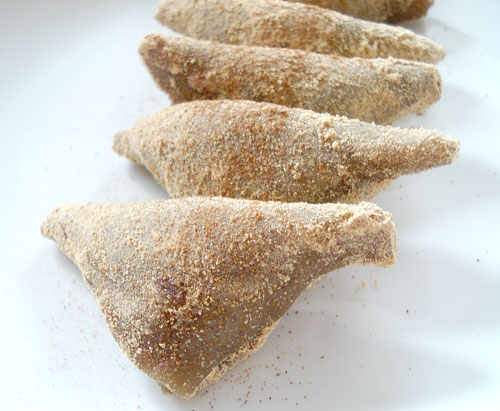
Just about anyone who takes a trip to the historical city of Kyoto goes home bearing a box of yatsuhashi (八つ橋), a small delicate sweet that is flavored with nikki or cinnamon. While I am not from Kyoto, I get a fit of nostalgia for yatsuhashi on occasion. Fortunately they aren't that hard to make at home. Added bonuses: they are more or less fat free, gluten-free, and vegan!

Filed under:
dessert japanese sweet tea vegan gluten-free wagashi
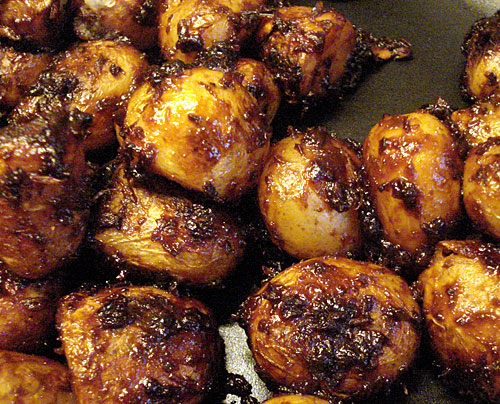
Here is another great way to enjoy new potatoes. It's almost as simple to make as new potatoes with soy sauce and butter, though it uses a few more ingredients. Boiled whole new potatoes are panfried in a little sesame oil, then coated in a sticky sweet-salty-spicy miso sauce. The strong flavors of the miso sauce really go well with the blandness of the potatoes.
Filed under:
japanese potatoes miso vegan
Pages